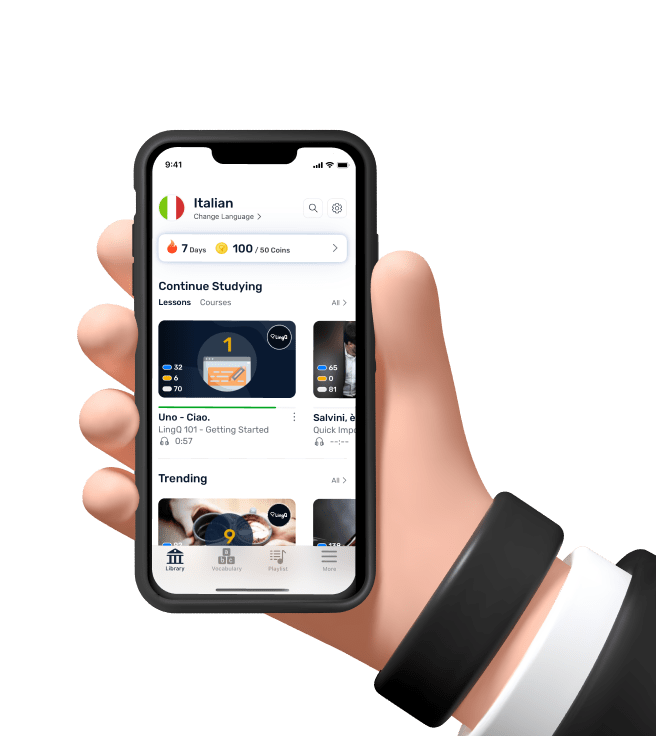How to pronounce 'GLI' in Italian (practical tip) (Sub ITA)
How to pronounce 'GLI' in Italian (practical tip) (Sub ITA)
Ciao a tutti e bentornati sul mio canale!
Hello everyone and welcome back to my channel!
Oppure benvenuti se questa è la prima volta che guardate un mio video.
Or welcome if this is your first time watching a video of mine.
Ou bienvenue si c'est la première fois que vous regardez une de mes vidéos.
Io mi chiamo Lucrezia, sono di Roma e insegno l'italiano agli studenti stranieri
My name is Lucrezia, I am from Rome and I teach Italian to foreign students
Je m'appelle Lucrezia, je suis de Rome et j'enseigne l'italien à des étudiants étrangers
su internet e nella vita reale.
on the internet and in real life.
sur Internet et dans la vraie vie.
Prima di iniziare,
Before we start,
Avant de commencer,
mi raccomando, ricordatevi di attivare i sottotitoli.
please remember to activate subtitles.
n'oubliez pas d'activer les sous-titres.
Nel video di oggi parliamo del suono 'GLI'
In today's video we'll talk about the 'GLI' sound
Dans la vidéo d'aujourd'hui, nous parlons du son 'GLI'
Perché qualche giorno fa vi ho chiesto di mandarmi alcune parole che trovate difficili da pronunciare
Because a few days ago I asked you to send me some words that you find difficult to pronounce
Parce qu'il y a quelques jours je vous ai demandé de m'envoyer des mots que vous avez du mal à prononcer
e le parole con il suono 'GLI'
and words with the sound 'GLI'
et des mots avec le son 'GLI'
erano le risposte ricorrenti e quindi ho pensato di dedicare un intero video a questo suono.
were the recurring answers and so I thought I'd dedicate an entire video to this sound.
étaient les réponses récurrentes et j'ai donc pensé consacrer une vidéo entière à ce son.
Possiamo trovarlo scritto in due modi:
We can find it written in two ways:
On peut le trouver écrit de deux manières:
GL + I GLI + A, E, O, U
GL + I GLI + A, E, O, U
GL + I GLI + A, E, O, U
Andando quindi a formare 'GLI', 'GLIA', 'GLIE', 'GLIO', 'GLIU'.
Thus going to form the following sounds 'GLI', 'GLIA', 'GLIE', 'GLIO', 'GLIU'.
Ainsi on va former 'GLI', 'GLIA', 'GLIE', 'GLIO', 'GLIU'.
E questo è il fonema.
And this is the phoneme.
Et c'est le phonème.
Si tratta di una consonante laterale palatale sonora.
It is a voiced palatal lateral consonant.
C'est une consonne latérale palatine sonore.
Soprattutto questo aggettivo,
Especially this adjective,
Surtout cet adjectif,
palatale, ci aiuterà più tardi per esercitarci nella pronuncia.
palatal, will help us later to practice pronunciation.
palatal, cela nous aidera plus tard à pratiquer la prononciation.
Vediamo alcune parole con questo suono: aglio, figlie, conchiglia, tagliuzzare.
Let's see some words with this sound: garlic, daughters, shell, shred.
Voyons quelques mots avec ce son: aglio, foglie, conchiglia, tagliuzzare.
Sono sicura che in questo momento
I'm sure that
Je suis sûre maintenant que
state pensando che questo suono è un suono difficilissimo da pronunciare,
you are thinking that this sound is a very difficult sound to pronounce,
vous pensez que ce son est un son très difficile à prononcer,
in realtà possiamo esercitarci a pronunciarlo, perciò non preoccupatevi!
we can actually practice pronouncing it, so don't worry!
Mais nous pouvons nous entraîner à le prononcer, alors ne vous inquiétez pas!
Dobbiamo solamente usare il nostro apparato fonatorio per pronunciare questo suono.
We just have to use our speech apparatus to pronounce this sound.
Nous devons simplement utiliser notre organe vocal pour prononcer ce son.
Qui accanto a me vedrete una fotografia che spiega quali sono tutte le parti dell'apparato fonatorio.
Here next to me you will see a photograph explaining what all the parts of the speech apparatus are.
Ici, à côté de moi, vous verrez une photographie expliquant ce que sont toutes les parties de l'organe de la parole.
Per pronunciare il suono 'GLI' ci servono nello specifico la lingua e il palato.
To pronounce the sound 'GLI' we need specifically the tongue and the hard palate.
Pour prononcer le son «GLI», nous avons besoin spécifiquement de la langue et du palais.
Per aiutarvi a capire come pronunciare questo suono,
To help you understand how to pronounce this sound,
Pour vous aider à comprendre comment prononcer ce son,
io partirei da un altro suono che è in contrasto con il suono 'GLI',
I would like to start with another sound that is in contrast to the 'GLI' sound,
Je commencerais par un autre son qui contraste avec le son 'GLI',
che è il suono /l/.
which is the sound / l /.
qui est le son / l /.
Il suono /l/, quello della lettera L.
The sound / l /, that of the letter L.
Le son / l /, celui de la lettre L.
Voglio partire da questo suono, perché siccome è semplice da pronunciare,
I want to start with this sound, because since it is simple to pronounce,
Je veux commencer par ce son, car comme il est simple à prononcer,
voi già lo pronunciate comunemente,
you already pronounce it commonly,
vous le prononcez déjà couramment,
andiamo a capire come si muove
we'll go ahead and understand how we move
allons-y et comprenons comment bouge
l'apparato fonatorio quando pronunciamo /l/
the speech apparatus when we pronounce / l /
l'organe vocal quand on prononce / l /
e per pronunciare poi 'GLI'
and then to pronounce 'GLI'
puis pour prononcer 'GLI'
dobbiamo semplicemente fare un movimento opposto.
we simply have to make an opposite movement.
nous devons simplement faire le contraire.
La consonante /l/ è alveolare,
The consonant / l / is alveolar,
La consonne / l / est alvéolaire,
significa che quando noi pronunciamo /l/,
it means that when we pronounce / l /,
cela signifie que lorsque nous prononçons / l /,
la nostra lingua forma una curva verso il basso e la punta della nostra lingua va a toccare gli alveoli,
our tongue forms a downward curve and the tip of our tongue touches the alveoli,
notre langue forme une courbe descendante et le bout de notre langue touche les alvéoles,
la parte di contatto tra i denti e il palato, nella parte alta della bocca.
the part of contact between the teeth and the palate, in the upper part of the mouth.
la partie de contact entre les dents et le palais, dans la partie supérieure de la bouche.
Fateci caso, provate a pronunciare /l/.
Pay attention to the movement, try to pronounce / l /.
Remarquez-le, essayez de prononcer / l /.
Ovviamente l'aria esce dalla bocca, non dal naso.
Obviously the air comes out of the mouth, not the nose.
De toute évidence, l'air sort de la bouche, pas du nez.
Se questo è il palato, qui abbiamo i denti.
If this is the palate, here we have the teeth.
Si c'est le palais, nous avons ici les dents.
Per pronunciare /l/ la nostra lingua farà così: la punta tocca questo punto qui.
To pronounce / l / our tongue will do this: the tip touches this point here.
Pour prononcer / l / notre langue fera ceci: la pointe touche ici ce point.
Questa è la nostra lingua.
This is our tongue.
C'est notre langue.
Per pronunciare 'GLI' dobbiamo portare la punta della nostra lingua verso il basso
To pronounce 'GLI' we have to bring the tip of our tongue down
Pour prononcer 'GLI' nous devons abaisser le bout de la langue
e far toccare il dorso della lingua con il palato.
and let the back of the tongue touch the palate.
et laissez le dos de la langue toucher le palais.
Quindi adesso cosa facciamo? Proviamo a pronunciare il suono /l/,
So what do we do now? Let's try to pronounce the sound / l /,
Donc que faisons-nous maintenant? Essayons de prononcer le son / l /,
mettendo la lingua in questa posizione,
putting the tongue in this position,
En mettant la langue dans cette position,
incurvando la lingua verso l'alto - quindi la curva della lingua deve toccare il palato.
curving the tongue upwards - then the curve of the tongue must touch the palate.
courber la langue vers le haut - alors la courbe de la langue doit toucher le palais.
Ci stiamo avvicinando a quel suono.
We are getting closer to that sound.
Nous nous rapprochons de ce son.
Adesso pensiamo all'aria: da dove esce l'area quando io pronuncio 'GLI'?
Now let's think about the air: where does the air come out of when I say 'GLI'?
Pensons maintenant à l'air: d'où vient l'air quand je dis «GLI»?
Esce dalla bocca, non esce dal naso. Quindi proviamo a pronunciare /l/
It comes out of the mouth, it does not come out of the nose. So let's try to pronounce / l /
Ça sort de la bouche, ça ne sort pas du nez. Essayons donc de prononcer / l /
con il dorso della lingua che tocca il palato e quindi la punta della lingua verso il basso,
with the back of the tongue touching the palate and then the tip of the tongue down,
avec l'arrière de la langue touchant le palais, puis la pointe de la langue vers le bas,
e tappiamoci il naso.
and let's hold our noses.
et retenons notre nez.
Si avvicina molto al suono che noi dobbiamo riprodurre.
It comes very close to the sound we need to reproduce.
Il est très proche du son que nous devons reproduire.
Quindi, una volta capita la posizione della lingua nella nostra bocca e dove far uscire l'aria,
So, once we understand the position of the tongue in our mouth and where to let the air out,
Donc, une fois que nous comprenons la position de la langue dans notre bouche et où laisser sortir l'air,
a questo punto è solamente una questione di esercizio.
at this point it is only a matter of exercise.
à ce stade, ce n'est qu'une question d'exercice.
Questo approccio contrastivo può aiutarci ad esercitarci. Adesso io non so se questo è un metodo che si usa
This contrastive approach can help us practice. Now I don't know if this is a method that is used
Cette approche peut nous aider à pratiquer. Maintenant je ne sais pas si c'est une méthode qui est utilisée
comunemente, non lo so. Però è un metodo che funziona,
commonly, I don't know. But it is a method that works,
généralement, je ne sais pas. Mais c'est une méthode qui fonctionne,
perché lo consiglio spesso ai miei studenti
because I often recommend it to my students
car je la recommande souvent à mes étudiants
e alla fine loro riescono a pronunciare questo suono.
and eventually they manage to pronounce this sound.
et finalement ils parviennent à prononcer ce son.
Ovviamente ci vuole un po' di esercizio, ci vuole un po' di pazienza! Ma è assolutamente possibile
Obviously it takes a little practice, it takes a little patience! But it is absolutely possible
Evidemment cela demande un peu de pratique, il faut un peu de patience! Mais c'est absolument possible
riprodurre questo suono, il suono 'GLI'.
to replicate this sound, the 'GLI' sound.
De reproduire ce son, le son «GLI».
Va bene?
All right?
Tout va bien?
Allora spero che questa lezione vi sia utile.
Then I hope this lesson is useful to you.
Alors j'espère que cette leçon vous sera utile.
Grazie per aver guardato questo video.
Thanks for watching this video.
Merci d'avoir regardé cette vidéo.
Noi ci vediamo nel prossimo.
I'll see you in the next one.
Nous vous voyons dans la prochaine.
A presto, ciao!
See you soon, bye!
A bientôt au revoir!

